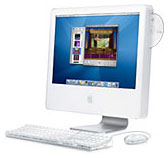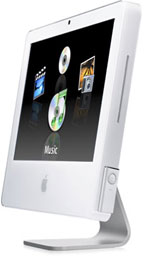Macintosh History
2005: Mac mini, Mac OS X 10.4 'Tiger', iSight iMacs, Dual-Core Power Macs, Hi-res PowerBooks, and More
Dan Knight - updated 2008.02.10 - Tip Jar
Macworld Expo: Mac mini & iPod shuffle
Apple began 2005 with a big bang from a little computer - the Mac mini. For the first time since 1997, when Apple introduced the Power Mac 6500 and Power Mac G3, they had a desktop Mac intended for consumers that didn't have a built-in display. At US$499, it was also the least expensive Macintosh Apple had ever offered.
The Mac mini is an unusual desktop computer. It's tiny, as the name implies, measuring just 6.5" square and 2" tall. Inside is an optical drive (Combo or SuperDrive), 2.5" hard drive, room for AirPort Extreme and Bluetooth, and one slot for memory. There are no expansion slots, and there's no internal power supply - there's no room.
The Mac mini also marked one more first for Apple. Every previous desktop Mac had shipped with a mouse, and all USB ones had included a keyboard. Neither came with the mini.
The Mac Web was abuzz about the new computer, something several of us had been suggesting Apple build for years.
On the iPod side of things, Steve Jobs unveiled the iPod shuffle, the first iPod to use flash memory instead of a hard drive. It was also the first iPod with no display. "Life is random."
Because of its size, the iPod shuffle didn't have room for a dock connector. Instead, Apple built a USB 2.0 plug right into the shuffle. It was the first iPod that didn't support FireWire.
January 12
Apple announced its best quarter ever. The holiday 2004 quarter had generated US$295 million in profits. That included over 1 million Macs (up 25% from the previous year) and 4.5 million iPods.
January 31
The 12" PowerBook G4 hit 1.5 GHz at the end of January, while the 15" PowerBook G4 and its 17" sibling topped that at 1.67 GHz. Bluetooth 2.0 became a standard feature, and Apple also added a scrolling trackpad and sudden motion sensor to the mix.
February 23
The popular 4 GB iPod mini was replaced with two new iPod mini models that had new circuitry inside. This boosted play time from 8 hours on a full charge to 18 hours. The new 4 GB iPod mini sold for US$199, and the 6 GB model was US$249.
The only other change in the iPod mini line was discontinuing gold, the least popular color.
April 13
Apple saw almost as much in profits during the first calendar quarter of 2005 as it did during the holiday quarter of 2004 - US$290 million. Once again, Mac sales topped 1 million units, and iPod sales had increased to 5 million.
April 27
Two weeks later, Apple unveiled improved Power Mac G5s. Each model had dual processors, and speeds ranged from 2.0 GHz to 2.7 GHz, the highest clock speed of any PowerPC Mac ever built.
SuperDrive speed increased to 16x, video RAM was doubled, and "Tiger" (Mac OS X 10.4) came preinstalled.
April 29: Tiger
Speaking of Tiger, Mac OS X 10.4 was officially released two days later. The hot new technologies were Dashboard, Spotlight, and Automator. Tiger would would go on to be the longest shipping version of Mac OS X, remaining on the market until October 2007, which it was finally replaced by Mac OS X 10.5 "Leopard".
Tiger was the last version of OS X to support G3 Macs and to officially support G4 Macs slower than 867 MHz - Leopard would require a G4, AGP graphics, 512 MB of RAM, and an 867 MHz CPU, although clever users found ways to work around the latter two requirements.
 May 3
May 3
The thin iMac G5 received a 200 MHz speed boost to 1.8 GHz and 2.0 GHz. For the first time, an iMac included gigabit ethernet. The updated faster models also ran had an 8xSuperDrive with dual-layer support.
June 6: Intel Inside
Steve Jobs shocked the Mac faithful on June 6 by announcing that Apple would be migrating to Intel CPUs, although the first "Macintel" models might not be available for a year.
Apple had a long history of porting the Mac OS to Intel, starting with the Star Trek project, and every version of OS X had been compiled in-house for Intel as well as PowerPC chips.
Many of us on the Mac Web had pooh-poohed the idea, because Intel-based Macs would have to be incompatible with the huge installed base of Mac software. Apple addressed that with Rosetta, a PowerPC emulator that allows most PowerPC OS X software to run on Intel-based Macs.
The only hole in backward compatibility was Classic Mode, which is not available on Macintel models. Those of us who love Claris Home Page, Claris Emailer, older versions of Photoshop, vintage Mac games, etc. will want to stick with PowerPC models until we find suitable replacement software or someone creates a working Classic Mode for Macintel hardware.
Macworld Boston: July 11-14
Macworld made an enemy of Apple when IDG announced that the July Macworld Expo would move the from New York the Boston. Apple refused to exhibit at the 2004 and 2005 Boston shows.
Due to lackluster attendance and Apple's boycott, IDG World Expo announced in Sept. that it was canceling the East Coast Expo.
July 26
Apple speed bumped the iBooks, moving the 12" model to 1.33 GHz and the 14" model to 1.42 GHz. Standard memory was increased to 512 MB, and Bluetooth 2.0 became a standard feature.
To simplify the iBook line, there was no longer a 14" model with a Combo drive.
At the same time, Apple also moved the Mac mini to a 512 MB base memory configuration and made AirPort Extreme and Bluetooth 2.0 standard on the 1.42 GHz model.
August 2: Mighty Mouse
Starting with Apple's Lisa in 1983, Apple had never shipped a mouse with more than a single button. In fact, the company had even invented a "no button" mouse in which the entire mouse was the button.
A lot of Mac users wanted more than one button, and companies such as Logitech, Microsoft, Kensington, and countless others offered USB mice with two or more buttons - and often with scroll wheels as well.
Apple's Mighty Mouse (although Apple had licensed the name from CBS, which owned the Mighty Mouse cartoons, a company called Man & Machine had been using the name for its mice before Apple's came to market and sued over the name) gave Mac owners the opportunity to buy an Apple-branded mouse with extra capabilities. You could use one side as a right-click, the other as a left-click. You could squeeze it - and use software to define what your Mac did when the mouse was squeezed.
The Mighty Mouse had three innovations, one in software and two in hardware. The first was that it would behave exactly like a single-button mouse unless you changed that behavior in System Preferences. The second was that there were no separate right and left buttons. Instead, Mighty Mouse detected which side you were pressing.
Finally, Apple skipped right past the scroll wheel and scroll wheel with horizontal tilt used by the rest of the industry and introduced a pea-sized trackball on top of the mouse. This can be used to scroll vertically, horizontally, or at an angle.
September 7: iPod nano
The iPod mini, Apple's most popular model ever, was discontinued on Sept. 7 and replaced with the iPod nano. Slim and tiny, the iPod nano had 2 GB or 4 GB of flash memory, a color screen, and shipped in white and black.
The iPod nano was the first iPod with a screen that didn't support FireWire, and also the first that didn't ship with an AC adapter for charging the unit.
On the down side, the iPod nano was extremely susceptible to scratching, leading to several class action suits against Apple and a burgeoning range of protective covers and cases.
September 24
There was much joy in Macville when Apple announced its best fiscal quarter ever with a net profit of US$430 million. Sales included over 1.2 million Macs (up almost 50% over 2004) and nearly 6.5 million iPods.
This also marked the end of Apple's best fiscal year ever.
Shhhh, Don't Say a Word
On or about Sept. 28, Apple began shipping an updated Mac mini without ever officially announcing it. The new models ran at 1.33 GHz and 1.5 GHz, slightly faster than the models they replaced.
The SuperDrive model now has an 8x drive, and the 1.5 GHz Mac mini has 64 MB of video memory - twice as much as the 1.42 GHz model. Also, 5400 rpm hard drives were now standard (vs. 4400 in earlier minis).
Without opening the box it came in, there is no way to know whether you were receiving the improved model or not. Apple only maintained that you will get "at least" the specs advertised for the original Mac mini.
 October 12
October 12
The iMac G5 was redesigned, and the model introduced on Oct. 12 was thinner, 100 MHz faster, and included a built-in iSight webcam. To our knowledge, this was the first time a desktop computer included a built-in webcam.
The new iMac G5 was the first Mac to use the PCI Express bus, and it also supported DDR2 memory. The 17" model ran at 1.9 GHz, the 20" at 2.1 GHz.
In another Apple first, these were the first iMacs without a built-in modem (not counting some earlier education-only CD-ROM models).
At the same time, the full-sized iPod was upgraded with a 320 x 240 2.5" display and the ability to play video. Apple also announced that some ABC television programs would be available through the iTunes Music Store at US$1.99 per episode.
As with the iPod nano, the AC charger didn't ship with the 5G iPod and there was no support for FireWire. That was a real disappointment to longtime Mac users, since Apple had offered FireWire on Macs since 1999 but didn't include USB 2.0 until 2003, long after it had become standard on all Windows PCs.
October 19: Hi-res PowerBooks and Dual-core Power Macs
The PowerBook line saw one more revision. The new 15" PowerBook G4 saw resolution increased from 1280 x 854 to 1440 x 900, and the new 17" PowerBook G4 received a 1680 x 1050 display instead of the 1440 x 900 of earlier 17" models.
Unfortunately, the new displays had some teething problems, and there was widespread reporting of horizontal bands on the new screens.
At the same time, the Power Mac went into it's PowerPC incarnation. The Power Mac G5 Dual included a dual-core 2.0 or 2.3 GHz G5 CPU and PCI Express architecture.
Need more power? The Power Mac G5 Quad was built around a pair of dual-core 2.5 GHz G5 CPUs. It was the most powerful PowerPC Mac ever.
Next - 2006: The Mac Goes Intel
About LEM Support Usage Privacy Contact
Follow Low End Mac on Twitter
Join Low End Mac on Facebook
Favorite Sites
MacSurfer
Cult of Mac
Shrine of Apple
MacInTouch
MyAppleMenu
InfoMac
The Mac Observer
Accelerate Your Mac
RetroMacCast
The Vintage Mac Museum
Deal Brothers
DealMac
Mac2Sell
Mac Driver Museum
JAG's House
System 6 Heaven
System 7 Today
the pickle's Low-End Mac FAQ
Affiliates
Amazon.com
The iTunes Store
PC Connection Express
Macgo Blu-ray Player
Parallels Desktop for Mac
eBay

